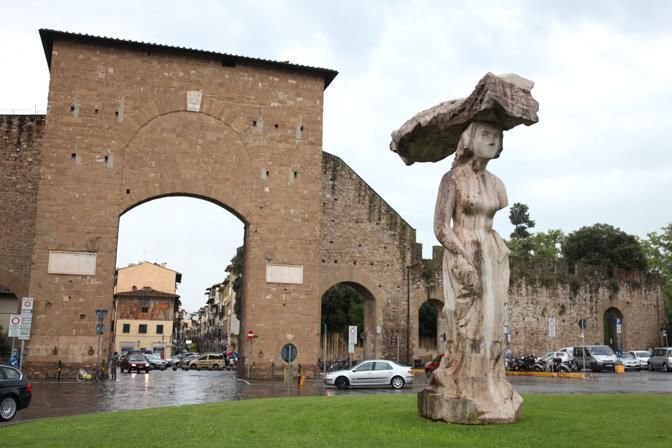A marble statue of Michelangelo Pistoletto, an Italian painter, action and object artist, and art theorist, stands in the square in front of Porta Romana in Florence in the center of a roundabout. It is from here that Robert and Sienna start their adventure in the novel Inferno.
Pistoletto’s statue is named Dietro-Front (Turnabout). Before describing this statue, it is necessary to say a few words about its location, ie., facing Porta Romana. In Inferno, Dan Brown describes Porta Romana as one of Florence’s busiest intersections—the gateway to the old city. Porta Romana belongs to the ancient walls of Florence, dating back to the 14th century, and is the largest and best preserved of the city gates.
The gate was built in 1326 during construction of the last set of walls. Since that time, it has undergone several changes. It is the most southerly of Florence’s walls, located on the road to Siena and Rome, hence the name.
This gate still has its original iron doors, with the typical large bolts (for decorative and pragmatic purposes), the old locks, and a marble slab bearing the Medici coat of arms.
Porta Romana is at the end of two boulevards: Viale del Poggio Imperiale and Viale Machiavelli. From here, Via Romana leads the way to Florence’s historic center.
Porta Romana is characterized by the great Pistoletto’s sculpture. The Dietro-Front statue consists of two large (about six meters high) female figures, the vertical one pointing toward Via Senese, which leads to Via Cassia, and then to Rome; the other one (about three meters high) placed on the head of the former and looking toward Via Romana, which begins inside the city walls of Florence.
The sculpture was presented for the first time in 1984 at the artist’s exhibition at Forte Belvedere, the Florentine fortification built between 1590 and 1595 to protect the city and its rule by the Medici family. Later, the sculputure was permanently placed in Piazzale di Porta Romana.
However, the Florentines, accustomed to the works of another Michelangelo (Buonarroti), were not particularly grateful. Consequently, the sculpture was immediately renamed “headache” by some, the “unbalanced” by others. Even today, some people use those nicknames when referring to that sculpture.
In 1984, there was also a protest. After chaining the fourteenth-century city gate in front of which Dietro-Front was placed, protesters collected hundreds of signatures demanding that thesculpture be moved to a suburban area of the city. After brief discussion among city members, it was decided that the sculpture was to remain in its place.
Since the symbolic significance of the statue was not immediately understood by the citizens, Pistoletto himself had to explain the meaning of his work of art during an interview. He said that: “The Dietro-Front sculpture has a clear meaning. It’s bi-directional, a figure walks one way while carrying a second figure on its head which walks the other way. From Florence during the Renaissance new ideas were born in artistic, scientific architectural and economic areas. Everything modern starts from this point, from Florence. My sculpture leaves Florence to face the world and at the same time the second figure returns: it is a come-back to modernity from the world to Florence”.
This was the author’s perspective, but everyone can interpret it in her/his own manner.
Perhaps it could also symbolize the attractiveness and charm that Florence is able to have on each of us: even if you try to escape, you cannot leave this city full of Renaissance treasures.
However, even if the Florentines have not been particularly taken by Pistoletto’s works of art, he leaves an original artwork that is by now considered an iconic reference to the area of Porta Romana, well-integrated into the city.
Picture by 055firenze.it








